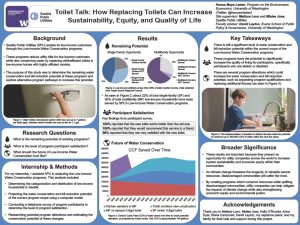Toilet Talk: How Replacing Toilets can Increase Sustainability, Equity, and Quality of Life
At the intersection of system sustainability and economic equity, Seattle Public Utilities (SPU) assists its customers through Low-Income Water Conservation Programs. These programs aim to reduce utility bills for low-income customers while also conserving the city’s water supply by replacing old and inefficient toilets in low-income homes with newer and highly efficient models. However, program participation has been rapidly declining in recent years. In order to continue its mission of assisting low-income customers while also conserving water, SPU must analyze these programs and decide whether or not they are achieving their objectives. The purpose of this study was to determine the remaining water conservation and bill reduction potential of these programs, and to explore other program pathways which may increase this potential. To accomplish this task, I helped build a functional model with the ability to project the conservation and bill reduction potential of various measures across several years. I also conducted a telephone survey of program participants in order to determine customer satisfaction. My findings suggest that these programs not only have remaining potential to save money and water, but can also significantly increase the quality of living for participants. Additionally, there are several program pathways available which can greatly increase this potential. These results imply a major opportunity for city governments to increase the long-term system sustainability of their natural resources while also promoting economic equity and increased living standards within their communities.
